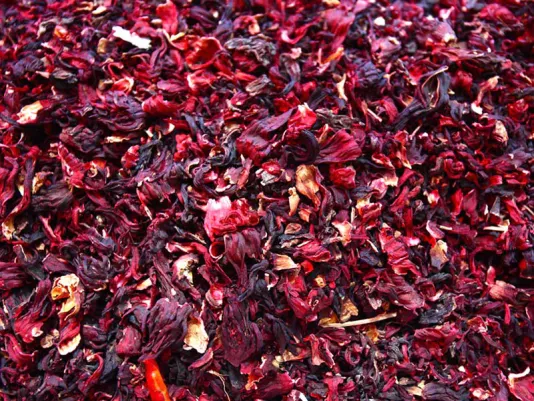Iced Hibiscus Tea
Iced Hibiscus Tea – summer, sun, heat, everyone is hiding in the cool, but there are those who are happy with this weather – this is hibiscus.

Hibiscus is dried hibiscus petals that impress with their depth of color and vibrant taste. In my experience, this ingredient can turn plain water into a drink with noble tartness and subtle fruity notes. I often use it as a natural coloring for sauces or syrups, where it adds not only color but also a distinctive flavor accent. When chilled, the infusion is wonderfully refreshing, especially in summer. The main thing is not to overbrew the petals, as excessive bitterness quickly overpowers the delicate aroma. Over the years, I’ve learned to sense the balance between richness and softness – this is what makes hibiscus a versatile ingredient in drinks, pastries, and desserts.
In my practice, choosing quality hibiscus always starts with the color and integrity of the petals. The best ones have a deep burgundy or purple hue, without dullness or gray impurities. When I open the package, the aroma should be clean, with fruity notes – without mustiness or dust. If the petals are too small or brittle, they have likely lost part of their essential oils and won’t provide full flavor. I always prefer whole petals, slightly crisp to the touch – they open best during steeping. It’s also worth noting the country of origin: Sudanese hibiscus usually has stronger acidity, while Egyptian is softer and more aromatic. Another criterion is ingredient purity: no added flavorings or dyes, since natural hibiscus has a self-sufficient taste. If the petals look too glossy, that’s a sign of processing. I store hibiscus in a tightly sealed glass jar, away from light and moisture, since even a small amount of condensation can cause spoilage. With proper storage, it retains freshness and aroma for at least a year.
I always steep hibiscus in glass or enameled dishes to avoid acid reacting with metal. I choose proportions based on purpose: for a rich drink, I use one tablespoon per glass of water; for culinary use, a bit less, so the color is deep but the flavor not too dominant. I pour hot water gradually, letting the petals open naturally without boiling. When time allows, I let it steep under a lid for 15-20 minutes – that’s enough to get a vivid color and a tangy note. For a more concentrated extract, it can be gently heated for a few minutes without bringing it to a full boil, and then strained. From my experience, the main mistake is letting it steep too long: after half an hour, the taste becomes bitter and the aroma fades. For cold drinks, petals can be soaked in cool water for several hours – the color turns softer but the taste fresher. I keep the finished infusion in the fridge for no more than two days and always shake it before use, as the petal particles settle naturally.
Temperature when working with hibiscus is key to balanced flavor. I’ve noticed that when the water is too hot, the petals quickly lose aroma and give sharp acidity, so the ideal temperature for steeping is about 90°C (194°F). If adding hibiscus directly to boiling liquid, such as syrup, the heat should be reduced and the warming brief, to preserve the natural acids. In desserts, I often use concentrated infusion as a natural coloring: when added to creams or glaze, it keeps its color only if the mixture has cooled. For citrus jams, I add the petals at the end of cooking – they leave a gentle tartness and a rich aroma without a metallic aftertaste. In chicken or turkey marinades, it’s important to ensure the infusion isn’t too sour – excess acidity softens the protein and makes the texture fibrous. That’s why I always taste the liquid before mixing. Hibiscus doesn’t tolerate long boiling but responds perfectly to short heating – the color stays clear, and the flavor remains bright and harmonious.
I describe hibiscus flavor as deeply berry-like with pleasant acidity reminiscent of cranberry or rosehip. This quality allows it to pair with many ingredients: from citrus and honey to ginger and mint. In my experience, it perfectly balances sweet drinks, adding a feeling of freshness. When making a compote or iced tea with hibiscus, a slice of orange or a few raspberries enhance its fruity depth. In meat sauces, it acts as the acidic component, replacing vinegar or wine, giving a subtle red hue and gentle tartness. In desserts, I pair it with meringue or cream – the acidity balances the richness, creating a clean flavor harmony. Hibiscus aroma intensifies with heat, so when cooling dishes it’s important not to overwhelm it with other strong scents like cinnamon or clove. In drinks, by contrast, a light hint of spice helps reveal its depth. I always feel that this ingredient adds character to dishes but never overpowers their own flavor.
Over the years of working with hibiscus, I’ve seen how small inaccuracies spoil the result. The most common mistake is using old or damp petals: they produce a cloudy infusion without aroma. To avoid this, I check the scent before each use – fresh petals always have a light fruity tone. Another issue is overconcentration: when people try to make the drink “stronger”, it turns out overly sour and bitter. The right balance comes from steeping time, not the amount of petals. I also don’t recommend stirring hibiscus with metal spoons while heating – the acid reacts, dulling the color. To maintain clarity, I always strain the infusion through a fine sieve or cheesecloth to avoid sediment. When using hibiscus in desserts, I cool the infusion to room temperature before mixing with dairy ingredients – this prevents protein curdling. Finally, I remember that no dye can replace the natural beauty of fresh hibiscus: only a quality product gives that deep ruby sheen that makes dishes truly appealing.